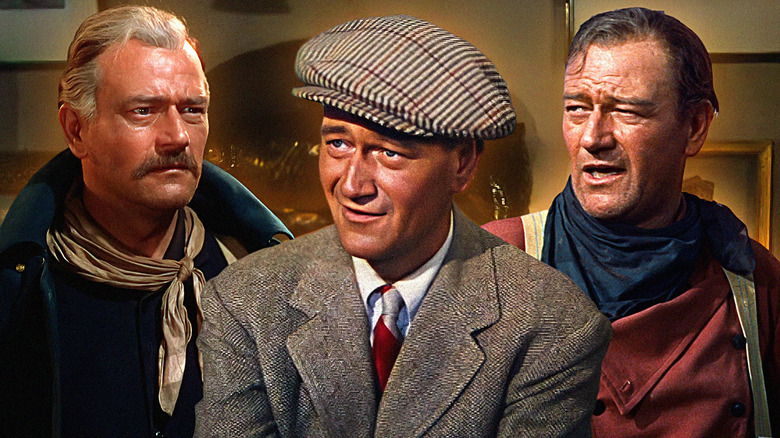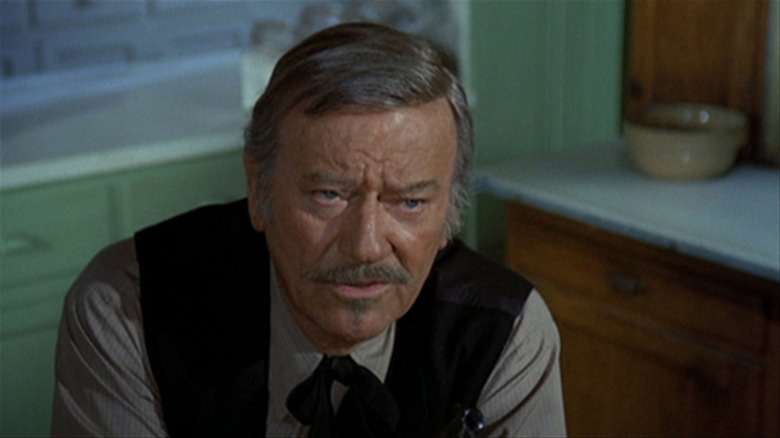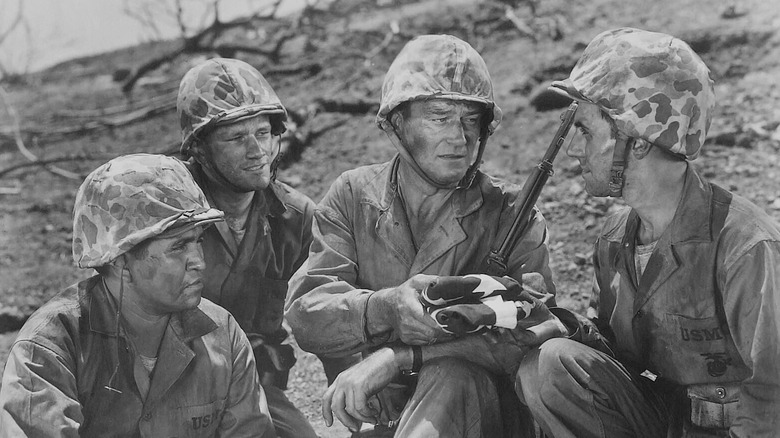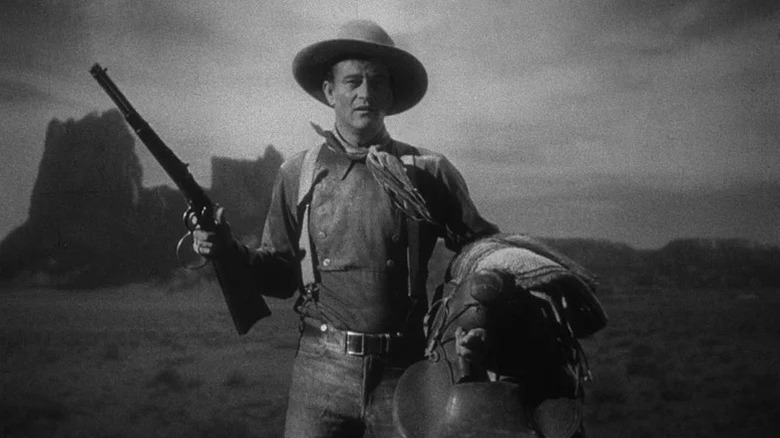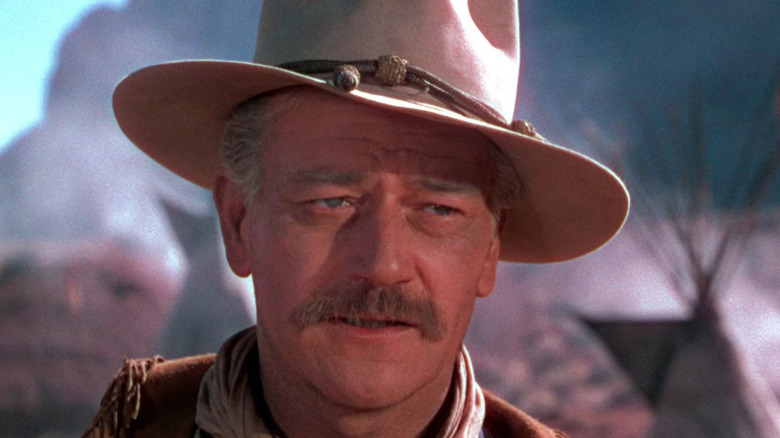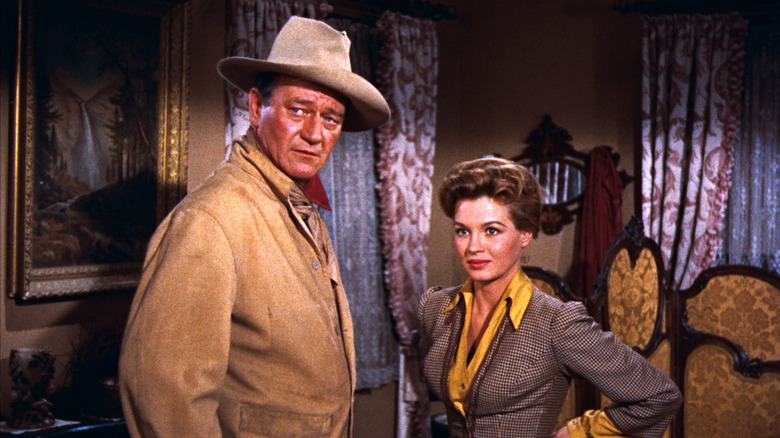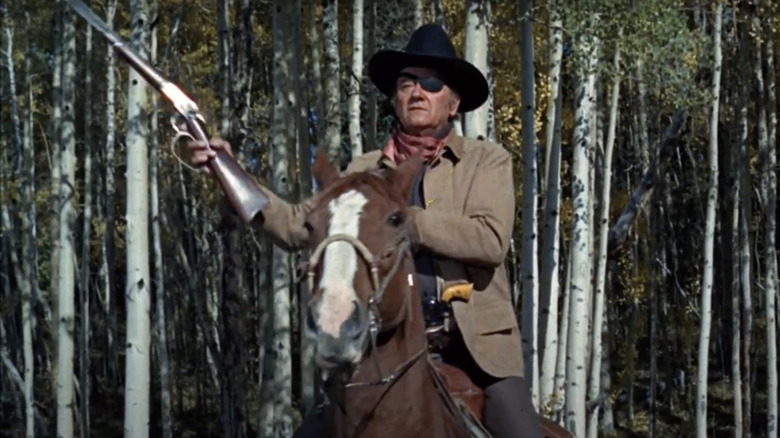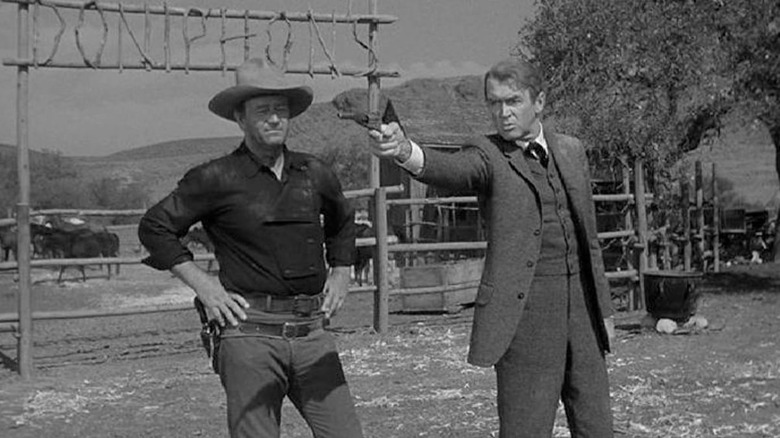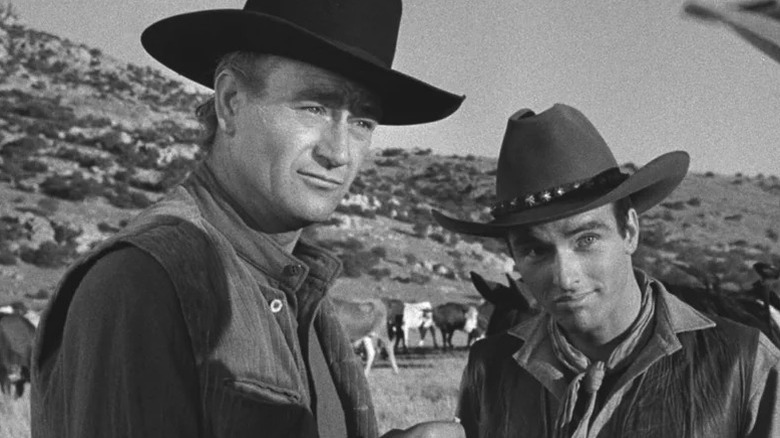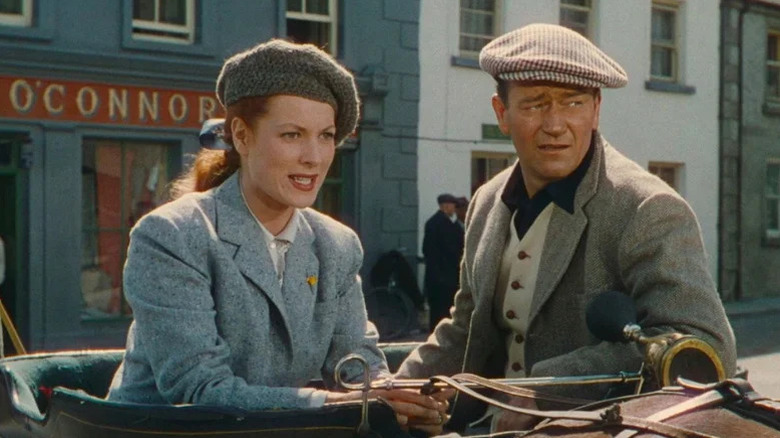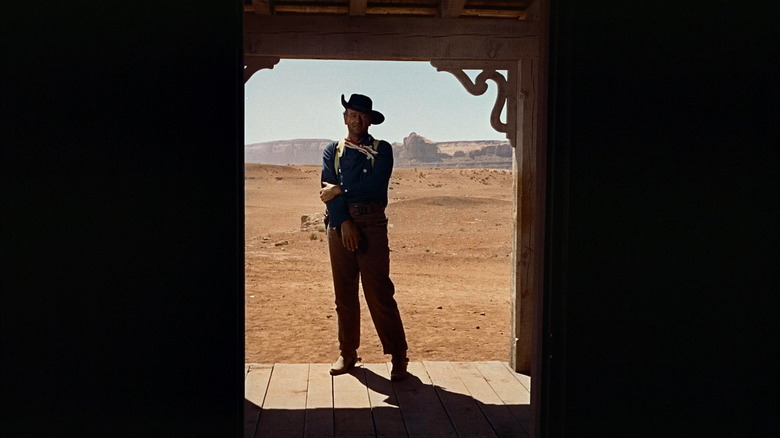John Wayne's 10 Best Roles, Ranked
Marion Morrison belongs on the Mount Rushmore (or should we say, Monument Valley?) of movie stars from the Golden Age of Hollywood. Never heard of him? We bet you have. He went by John Wayne. The American Film Institute inexplicably put him at number 13 on their list of 100 Biggest Stars (what were they smoking and where can we get some?). Sure, we love Humphrey Bogart, Katharine Hepburn, and Cary Grant too, but you won't see their mugs at highway gas stations nationwide splattered on every sort of memorabilia you can imagine. John Wayne, and John Wayne alone, was more than a movie star. He was a symbol of the country he called home, with all of its greatness and contradictions. These roles are the reason why.
This is not "John Wayne's Best Movies," though naturally there's considerable overlap. Sure, these are great movies, but we're not ranking the film's overall quality. This is about Wayne's work. Not just how good his performance was (don't listen to Wayne's critics; he could be a terrific actor) but how the roles defined his career. Since Wayne gave nearly 200 performances over a half-century career, narrowing them down wasn't easy. But as The Duke himself said: "Courage is being scared to death, but saddling up anyway." Okay, that's a bit hyperbolic given this is a movie article, but the internet can be a scary place.
So saddle up and join us on the trail as we count down John Wayne's best roles.
10. The Shootist
John Wayne's final film role was also one of his finest, as one of the greatest movie stars ever went out with a bang, literally and figuratively, in 1976's "The Shootist." In a case of art imitating life, Wayne plays J.B. Books, an aging gunslinger dying from cancer, a disease which Wayne had battled since the mid-1960s. With his mortality awaiting him, Books plants his flag in Nevada, where he rents a room from a widow (Lauren Bacall), while taking her son (Ron Howard) under his wing.
Trouble is never far from Brooks, as the sins of his past reappear in the form of a gunfighter named Mike Sweeney (Richard Boone), seeking vengeance for his brother, who Books killed years before. Facing his inevitable demise, Books decides he'd rather go out guns a-blazing, and concocts a scheme to take out Sweeney and his gang.
Wayne was battling cancer during the making of "The Shootist," as well as the film's director, Don Siegel. As the director of "Dirty Harry," Siegel was used to Eastwood's amoral, "shoot 'em in the back if you have to" style of gunslinger. But that wasn't Wayne. The Duke held firm, and thanks to his right to script approval, he changed the screenplay to protect his screen image. "The Shootist" is a better movie for it, as Brooks dies a hero, albeit a complicated one. Wayne went out the way he wanted in his cinematic sendoff, before riding off into his final sunset in 1979.
9. Sands of Iwo Jima
John Wayne war movies can be dicey. Wayne requested two deferments and never enlisted during World War II, noting he was his family's sole provider, earning him the "draft dodger" label. Yet Wayne's second deferment was rescinded as the U.S. military really needed men. That is, until the studios lobbied on his behalf, arguing Wayne was a morale booster. His deferment was granted "in support of the national interest."
Wayne's lack of service was always a sore spot, which his longtime collaborator (and noted bully) John Ford deployed frequently to berate him, to the point Wayne once stormed off the set. Wayne's guilt likely inspired his massive (and misguided) support of the Vietnam War, including making essentially government propaganda with the film, "The Green Berets," one of only two movies he directed.
That's a lot of background, but it helps set the stage for "Sands of Iwo Jima." Released in 1949, Wayne plays Marine Sgt. John Stryker, whose rough approach earns him no friends among his men, until it prepares them for one of the bloodiest battles of the Pacific Theater: the Battle of Iwo Jima. Wayne displayed a darker side to his screen persona, earning his first Oscar nomination in the process. Marine Sgt. Stryker is one of Wayne's best roles because it embodies the screen persona that movie studios championed years before: courage, sacrifice, grit, tenacity. While "Sand of Iwo Jima" came after the war, it was a message war-weary Americans very much needed to see.
8. Stagecoach
There are plenty of movies that made actors a star, from Julia Roberts in "Pretty Woman" to Leonardo DiCaprio in "Titanic." But "Stagecoach" is fascinating for film history, because you're not just watching the movie that made John Wayne a movie star, you can even witness the very moment when it happens. First, you hear Wayne's iconic drawl shout, "Hold it!" offscreen, and then the camera cuts to him atop a horse, rifle in hand, as the camera zooms into his face. Movie entrances don't come much bigger or better than that. This was one of the few instances director John Ford ever used the zoom, and there was a reason for it: He was making John Wayne a movie star.
It worked out pretty well for the both of them, but like the remainder of their relationship, it wasn't easy, as Ford bullied, belittled, and berated Wayne throughout the shoot. Whether it was "right" or "worth it" we won't say, but there's no denying Wayne delivers an A-list leading man performance, after more than a decade of bouncing around Hollywood as a B-movie cowboy actor. As escaped outlaw The Ringo Kid, Wayne plays the leader of a merry band of travelers who set out across the desert to reach Arizona with the threat of an Apache attack. "Stagecoach" shows us what Ford saw in Wayne, a mountain of a man who commands the screen with a performance every bit as big as the Monument Valley location.
7. She Wore A Yellow Ribbon
John Wayne and John Ford made an unofficial "Cavalry Trilogy," starting with "Fort Apache" in 1948 and concluding "Rio Grande" with in 1950. Really, any of them belongs on this list, but we're selecting the second film, 1949's "She Wore A Yellow Ribbon." "Fort Apache" and "Rio Grande" are more showcases for other frequent Ford collaborators, Henry Fonda and Maureen O'Hara respectively. Of the three, "She Wore A Yellow Ribbon" is the most definitive "John Wayne movie." It's also the movie where John Wayne gave his favorite performance.
Despite being in his early 40s, Wayne plays the sixtysomething Cavalry Captain Nathan Brittles, who's facing his last job before retirement: soothing relations between the Cheyenne and Arapaho following Custer's last stand, while also moving his commanding officer's wife (Mildred Natwick) and daughter (Joanne Dru) to a safe location.
Wayne later remarked (via Scott Eyman's biography "John Wayne: The Life and Legend"): "She Wore A Yellow Ribbon' turned out to be, I think, the best acting job I've ever done. As a matter of fact, it's about the only picture I've been in where I could play a character a little apart from the image that has developed for me over the years on the screen." Respectively, we disagree with Wayne's assessment this was his "best" performance (stay tuned), but it does display his under-appreciated range. While he thrived as the rugged, indomitable hero, in "Yellow Ribbon" he shows himself capable of playing a lion in winter who can still be called upon for one last ride.
6. Rio Bravo
"High Noon" is undeniably Gary Cooper's greatest performance. The 1952 film saved Cooper's career from descending into a "sea of crappy scripts" with its story of a retired marshal who must stand alone against a gunfighter's gang after he fails to recruit deputies to defend the town. Why are we talking about "High Noon" in a John Wayne list? Because Gary Cooper's definitive performance helped inspire one of Wayne's best roles. While the two actors were friends, Wayne hated "High Noon," a sentiment he shared with director Howard Hawks. In a case of an old school Hollywood clap back, the two made "Rio Bravo" in 1959.
Wayne plays Sheriff John T. Chance, who arrests Nathan Burdette (Claude Akins) for killing a man in a saloon shootout. Unfortunately, Burdette's crew comes to his rescue, forcing Chance to make a stand alongside a motley gang of misfits: the town drunk (Dean Martin), an elderly man (Walter Brennan), and a wet-behind-the-ears cowboy (Ricky Nelson). The similarities to "High Noon" are obvious, but while that film celebrates a hero abandoned by his cowardly townsfolk, "Rio Bravo" champions a community that comes together to face down villainy.
We won't pick one over the other as we love both, and are especially grateful "Rio Bravo" launched Wayne and Hawks' unofficial trilogy with 1966's "El Dorado" and "Rio Lobo" in 1970. Each are great, but "Rio Bravo" is tops for not only displaying Wayne as a hero, but as a leader of men.
5. True Grit
John Wayne was nominated for three Academy Awards in his career, but he only took home one Oscar, for 1969's "True Grit." In some ways, Wayne's win was an anomaly, as he defeated both Jon Voight and Dustin Hoffman for their performances in the Best Picture winner that year, "Midnight Cowboy." "True Grit" is a very different movie, and Wayne delivers a very different performance, almost like Hollywood was willing to welcome the impending "New Hollywood" movement of the 1970s but not without first honoring one of the Golden Age's greatest stars.
In "True Grit," Wayne plays U.S. Marshall Rooster Cogburn, a one-eyed lawman who is "double tough" but also "like to pull a cork." Cogburn is hired by Mattie Ross (Kim Darby) to travel to the Oklahoma Territory to track down the man who killed her Pa, and bring him to justice. It's a simple premise, elevated by the lingering language left over from Charles Portis' novel, which frankly was better embodied by the Coen Brothers' 2010 adaptation starring Jeff Bridges. But therein lies the distinction; this isn't a Portis' adaptation, but a Wayne star vehicle. Thus, Wayne's Oscar win was essentially a de facto Lifetime Achievement Award, which is appropriate, as Rooster Cogburn feels like The Duke delivering the ultimate "John Wayne performance." He's not stretching his acting muscles here so much as giving the kind of movie star performance that literally only he could deliver — and the result is pretty darn great.
4. The Man Who Shot Liberty Valance
"When the legend becomes fact, print the legend." That line from 1962's "The Man Who Shot Liberty Valance" is the most famous from any John Ford or John Wayne film. While it perfectly describes them both, ironically, the quote was actually uttered by a minor character at the end when the mystery of the movie's title is revealed.
"Liberty Valance" tells the tale of Tom Doniphon (Wayne), who rules the roost in a small western town but butts heads with newcomer attorney Ransom Stoddard (James Stewart) over frontier justice versus law and order. Plus, Doniphon's would-be sweetie (Vera Miles) prefers Stoddard. The two find a common foe in the titular Liberty Valance (Lee Marvin), whose gang terrorizes the town. Stoddard seemingly kills Valance in a shootout, riding on the wave of fame he gained all the way to the U.S. Senate. Come to find out (*spoiler alert for a 60-plus-year-old movie*), the man who actually shot Liberty Valance was Doniphon.
Wayne and Stewart (in his second of three Ford films) were probably too old for their respective roles, yet the two pros elevate each other with performances that threaten to melt the screen due to their combined movie star power. While 1963's "Donovan's Reef" was the final Wayne-Ford film, "Liberty Valance" feels like their true swan song. The two were saying goodbye not only to their collaboration but their career-long mythologizing of the American West, not to mention the legend they helped create together.
3. Red River
While John Wayne was best known for his 14 collaborations with John Ford, his other great director partner was Howard Hawks. While "Pappy" Ford was a father figure to Wayne (albeit an abusive one) who The Duke loved, despite their differences, Hawks was a sincere friend who shared Wayne's cinematic sensibilities. So it's appropriate that just as Ford made Wayne a movie star in "Stagecoach," Hawks gave Wayne his first opportunity to feel like a "real actor," and Wayne in turn saved Hawks' bacon by agreeing to be in his movie, lending his credibility as an established Western star.
The movie was "Red River" from 1948. Wayne and Hawks' first of five collaborations remains their best. Wayne plays Thomas Dunston, who grows a thriving Texas cattle ranch with the help of his protégé, Matt Garth (Montgomery Clift), an orphan he raised from boyhood. But the pseudo-father and son's clash on a cattle drive to Kansas threatens to not only cost them their relationship, but potentially their lives. The paternalistic cruelty Dunston shows Garth (perhaps Wayne was channeling Ford?) was risky.
"Red River" gave the heretofore goody two-shoes Wayne a meaty role to chew on, as he's essentially the film's antagonist. As Hawks said: "We were walking a tightrope in telling a story like that. Are you still going to like Wayne or not?" Given we still do once the credits roll showed that Wayne was more than a movie star; he was, indeed, a real actor.
2. The Quiet Man
As much as John Wayne (birth name Marion Morrison) and John Ford (birth name John Martin Feeney) were true blue American patriots, the two were equally enamored with the Emerald Isle from whence their ancestors came. So the two and their film crew set sail for the west of Ireland to make their cinematic love letter to the Emerald Isle, 1952's "The Quiet Man."
After accidentally killing an opponent in the ring, Irish-born boxer Sean Thornton (Wayne) leaves America for the green shores of his native Ireland to live a quiet life. Thornton's dreams are dashed by Will Danaher (Victor McLaglen), who envies Thornton for his land, and despises him for starting a romance with his spitfire of a little sister, Mary Kate, played by Maureen O'Hara in her second of five films with Wayne.
Fists are thrown (this is a John Wayne movie after all), but despite the talent in front of and behind the camera "The Quiet Man" is not a Western, war movie, or action pic, but a romantic comedy. Yes, John Wayne was in a romantic comedy — and was wonderful in it. He's matched by the beautiful Dublin-born Belle O'Hara, who gives her career-best performance. "The Quiet Man" feels like the John Ford stock company (including Wayne, O'Hara, McLaglen, Ward Bond, Mildred Natwick, and Barry Fitzgerald) having the time of their lives in Ireland, and just so happening to make a movie while they were there.
1. The Searchers
John Wayne's career-best performance was also the most complicated, as "The Searchers" manages to both challenge and champion the hatred that motivates its hero, Ethan Edwards (John Wayne), to embark on his five-year odyssey. Edwards is a Confederate veteran who returns home to Texas following the Civil War. When his brother's family is murdered by Comanches, and his niece Debbie (Natalie Wood) is abducted, Edwards leads her adopted brother Martin Pawley (Jeffrey Hunter) on a journey deep in Comanche territory. But during their half-decade quest, Pawley discovers that Edwards' mission isn't to rescue his niece; he aims to kill her for becoming a "Comanche squaw."
This is dark, deep, heavy-duty stuff that dares viewers to confront questions for which there are no easy answers. Is Edwards the hero or the villain? Is it ever justified to recruit violent people to restore peace and order? And once the rule of law has been reestablished, is it wrong to banish those same dangerous men for the good of the group?
While Wayne was no "method actor," the darkness of his performance consumed him even when off set. Wayne was fiercely protective of his heroic screen persona, but "The Searches" proves he was willing to tarnish it for the sake of the story. And what is that story? Fans of "The Searchers" will debate it forever, much like the legacy of its immortal movie star. What isn't up for debate is "The Searchers" is a masterpiece, and John Wayne's best role.
